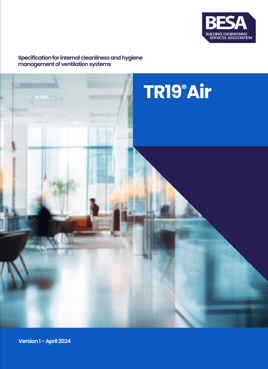A Guide to BESA TR19 Air in 2024
In October 2023, the Building Engineering Services Association (BESA) announced an update to their standard: TR19® 'Guide to Good Practice – Internal Cleanliness of Ventilation Systems'. It is now called TR19® Air to separate it from TR19® Grease, which covers fire risk management of grease accumulation within kitchen extraction. It was released on 15 April 2024.
TR19® Air is a widely recognised standard used in the HVAC industry as a reference for maintaining the cleanliness and hygiene of ventilation systems. It's particularly important in settings where air quality and hygiene are critical, such as healthcare facilities, commercial kitchens, cleanrooms, food prep facilities and many other workplaces where clean and uncontaminated air is essential.
 Click for a preview of the first 7 pages of the new document
Click for a preview of the first 7 pages of the new document
Why TR19 Air is important
Two key things: Occupant health and wellbeing, and building energy efficiency.
As building occupants become more aware of the impact of their environment on health and well-being, TR19 Air serves as an essential resource for facilities managers, ventilation hygiene specialists, owners, occupiers and specifiers tasked with addressing these challenges.
Accumulated debris in air ducts can impede airflow, forcing fans to work harder, resulting in increased energy consumption and wear and tear. Regular cleaning enhances system efficiency, leading to energy savings and prolonged lifespan, especially relevant for retrofitting buildings to achieve net-zero emissions. Moreover, cleaning ventilation systems mitigates unpleasant odours and reduces the risk of mould and condensation, known to exacerbate respiratory issues and allergies.
See our article on the 5 signs you need to clean your air ducts.
Employers and building managers are legally obligated under health and safety regulations to ensure the indoor environment remains safe, posing no risk to the health and well-being of workers and visitors. While cleaning ventilation ductwork has often been relegated to an 'out of sight, out of mind' task to cut costs, this approach is increasingly risky as stricter legislation scrutinises the safe operation of buildings.
Reasons for the updated TR19 2024
The original TR19® – 'Guide to good practice for the Internal Cleanliness of Ventilation Systems', aimed to comprehensively cover ventilation cleanliness. However, due to revisions and industry demand, a separate document, 'TR19® Grease', was created to focus on fire risk management in kitchen extraction systems. This was prompted by concerns from fire officers nationwide regarding poorly maintained systems in commercial kitchens.
Responding to a growing need for a targeted specification that enhances indoor air quality, BESA introduced the latest amendment: TR19® Air. This revision is part of a broader campaign to enhance indoor air quality (IAQ) in buildings, crucial in combating airborne pathogens and particulate matter, an issue made all the more pressing during the Covid-19 pandemic. The standard emphasises the role of ventilation systems in either spreading or preventing airborne contamination.
TR19® Air incorporates relevant legislation and professional guidance, including BS EN15780 ‘Cleanliness of Ventilation Systems’, the British and European Standard since 2011. It also aligns with the aspirations of the first British Standard for Health and Well-being in Buildings, BS 40102, published in 2023.
The standard, BS 40102-1:2023 – "Health and well-being and indoor environmental quality in buildings. Health and well-being in non domestic buildings. Code of practice," provides recommendations for measuring, monitoring, and reporting indoor environmental quality (IEQ). It includes an evaluation and rating system for air quality, lighting, thermal comfort, and acoustics, with ventilation hygiene companies playing a pivotal role in solutions.
See our guide to BS 40102-1:2023 and IEQ for more information.
TR19 key recommendations
TR19® Air underscores the importance of regular maintenance in removing dust, allergens, mould spores and other contaminants from air ducts, scientifically proven to reduce respiratory issues, allergies, headaches, fatigue and other health problems. Additionally, improving air quality in workplaces has shown to positively impact productivity.
Some of the key recommendations in the document for duct cleaning include:
Cleaning Standards: The document specifies cleaning standards and methods for various components of ventilation systems, including ductwork, grilles, diffusers, and fans.
Frequency of Cleaning: TR19 provides recommendations for how often different parts of the ventilation system should be cleaned. The frequency may vary depending on factors like the type of building, its use, and the level of contamination.
Hygiene and Safety: It emphasises the importance of maintaining hygiene and safety standards during cleaning operations, including the use of appropriate personal protective equipment (PPE) and cleaning agents.
Compliance with Regulations: TR19 is designed to help building owners, facility managers and HVAC professionals comply with relevant health and safety regulations and industry best practices.
See our article Duct Cleaning: UK Laws and Guidelines
Documentation: TR19 recommends keeping detailed records of cleaning and maintenance activities to demonstrate compliance with hygiene standards and regulations.
Verification and Certification: After cleaning, verification and certification procedures are often recommended to ensure that the ventilation system meets the required cleanliness standards.
For live updates on the new TR19 Air document, see our live article: BESA TR19 Air - 2023/24 (Live Updates)
Our services
As experts in air quality and compliance, we offer professional services such as fire damper testing and ductwork cleaning. If you have any questions, feel free to get in touch and we'll discuss how we can help keep your building TR19 compliant.






